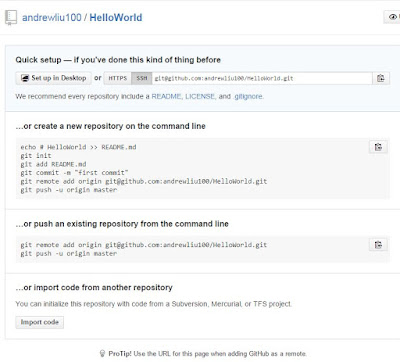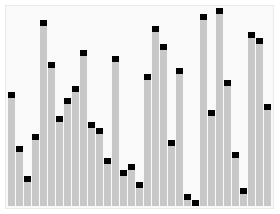I come across a problem of serializing Map type objects polymorphism when I re-engineering a legacy code. Spring MVC and Jackson are used in the RESTful API implementation. The problem is I have a list of Map type objects and they are in different implementation of Map. I want to serialize and deserialize the list with the actual type of each Map instance. For example, I have a list of map as below. One map is a HashMap and the other map is Hashtable.
List<Map> maps = new LinkedList<>(); Map<String, String> map1 = new HashMap(); Map<String, String> map2 = new Hashtable(); maps.add(map1); maps.add(map2);
With Jackson's default settings, the type information of map1 and map2 will be lost after serialization. And they both will be LinkedHashMap after deserialization which makes sense to Jackson because it doesn't know the actual type of map1 and map2 in deserilaization. Jackson does provide a @JsonTypeInfo annotation to resolve the polymorphism problem, but it only applies to the values of the map, not the map itself.
After several days search online, the best solution I found so far is to customize the TypeResolverBuilder class used by Jackson's ObjectMapper instance. However, it requires both server and client side to set the customized TypeResolverBuilder to the ObjectMapper instance, which means if your RESTful API is exposed to the public, you have to provide your clients with the customized ObjectMapper class. I know it is not ideal, so if you have a better solution, please let me know.
Now, the solution!
Firstly, write our own TypeResolverBuilder class. The important part is the useForType method. We override the method to return true if the type is a map like type.
public class MapTypeIdResolverBuilder extends StdTypeResolverBuilder {
public MapTypeIdResolverBuilder() {
}
@Override
public TypeDeserializer buildTypeDeserializer(DeserializationConfig config,
JavaType baseType, Collection<NamedType> subtypes) {
return useForType(baseType) ? super.buildTypeDeserializer(config, baseType, subtypes) : null;
}
@Override
public TypeSerializer buildTypeSerializer(SerializationConfig config,
JavaType baseType, Collection<namedtype> subtypes) {
return useForType(baseType) ? super.buildTypeSerializer(config, baseType, subtypes) : null;
}
/**
* Method called to check if the default type handler should be
* used for given type.
* Note: "natural types" (String, Boolean, Integer, Double) will never
* use typing; that is both due to them being concrete and final,
* and since actual serializers and deserializers will also ignore any
* attempts to enforce typing.
*/
public boolean useForType(JavaType t) {
return t.isMapLikeType() || t.isJavaLangObject();
}
}
Then, we need to set it to the ObjectMapper instance used by Jackson. We will also have to call init and inclusion methods, otherwise exceptions will be thrown at runtime. It is not required to use JsonTypeInfo.Id.CLASS and JsonTypeInfo.As.PROPERTY, you can use whatever you want provided by JsonTypeInfo annotation.
ObjectMapper objectMapper = new ObjectMapper(); MapTypeIdResolverBuilder mapResolverBuilder = new MapTypeIdResolverBuilder(); mapResolverBuilder.init(JsonTypeInfo.Id.CLASS, null); mapResolverBuilder.inclusion(JsonTypeInfo.As.PROPERTY); objectMapper.setDefaultTyping(mapResolverBuilder);
As I said earlier, both client side and server side of our RESTful API need to use the above ObjectMapper instance to do the serialization and deserialization. Because I am using Spring MVC. So I have to register the ObjectMapper instance to the MappingJackson2HttpMessageConverter used by Spring. If you are using a different framework with Jackson, it should provide a way to set the customized ObjectMapper instance, hopefully.
I will use the Java config instead of XML config in Spring. If you are using XML config, you can set the customized ObjectMapper instance as below, but it would be a bit tricky of how to call the init and inclusion methods in the ObjectMapper bean.
I will use the Java config instead of XML config in Spring. If you are using XML config, you can set the customized ObjectMapper instance as below, but it would be a bit tricky of how to call the init and inclusion methods in the ObjectMapper bean.
<mvc:annotation-driven>
<mvc:message-converters>
<bean class="org.springframework.http.converter.json.MappingJackson2HttpMessageConverter">
<property name="objectMapper" ref="customObjectMapper"/>
</bean>
</mvc:message-converters>
</mvc:annotation-drive>
The Java config I am using at server side is as below.
@Configuration
@EnableWebMvc
@ComponentScan("com.geekspearls.mvc.jackson.server")
public class AppConfig extends WebMvcConfigurerAdapter {
@Override
public void configureDefaultServletHandling(DefaultServletHandlerConfigurer configurer) {
configurer.enable();
}
@Override
public void configureMessageConverters(List<HttpMessageConverter<?>> converters) {
converters.add(converter());
}
@Bean
public MappingJackson2HttpMessageConverter converter() {
MappingJackson2HttpMessageConverter converter = new MappingJackson2HttpMessageConverter();
converter.setObjectMapper(objectMapper());
return converter;
}
@Bean
public ObjectMapper objectMapper() {
ObjectMapper objectMapper = new ObjectMapper();
MapTypeIdResolverBuilder mapResolverBuilder = new MapTypeIdResolverBuilder();
mapResolverBuilder.init(JsonTypeInfo.Id.CLASS, null);
mapResolverBuilder.inclusion(JsonTypeInfo.As.PROPERTY);
objectMapper.setDefaultTyping(mapResolverBuilder);
return objectMapper;
}
}
Then the client side class is as below. I am using the RestTemplate to call the RESTful service for simplicity.
public class ServiceConsumer {
private static final String REST_ENDPOINT = "http://localhost:8080/rest/api";
public InStock getInStock() {
ObjectMapper objectMapper = new ObjectMapper();
MapTypeIdResolverBuilder mapResolverBuilder = new MapTypeIdResolverBuilder();
mapResolverBuilder.init(JsonTypeInfo.Id.CLASS, null);
mapResolverBuilder.inclusion(JsonTypeInfo.As.PROPERTY);
objectMapper.setDefaultTyping(mapResolverBuilder);
List<HttpMessageConverter<?>> converters = new ArrayList<>();
MappingJackson2HttpMessageConverter jackson2HttpMessageConverter = new MappingJackson2HttpMessageConverter();
jackson2HttpMessageConverter.setObjectMapper(objectMapper);
converters.add(jackson2HttpMessageConverter);
RestOperations operations = new RestTemplate(converters);
InStock s = operations.getForObject(REST_ENDPOINT + "/book/in_stock", InStock.class);
return s;
}
}
The complete code example can be found in my GitHub in the mvc.jackson package. The example can be run in jetty server via 'mvn jetty:run' command. And you will get the following JSON message when hit the server with URL 'http://localhost:8080/rest/api/book/in_stock in the browser. As you can see, it contains the type information of the maps `"@class": "java.util.Hashtable"` and `"@class": "java.util.HashMap"`.
{
"store": "Los Angeles Store",
"books": [
{
"@class": "com.geekspearls.mvc.jackson.server.model.ChildrenBook",
"title": "Giraffes Can't Dance",
"isbn": "1-84356-568-3",
"properties": {
"@class": "java.util.Hashtable",
"Price": [
"java.lang.Float",
4.42
],
"Type": "Board book",
"Currency": "USD",
"Pages": 10
},
"minAge": 3,
"maxAge": 0
},
{
"@class": "com.geekspearls.mvc.jackson.server.model.TextBook",
"title": "Database Systems",
"isbn": "1-84356-028-3",
"properties": {
"@class": "java.util.HashMap",
"Pages": 560,
"Type": "HardCover",
"Price": [
"java.lang.Float",
146.16
],
"Currency": "USD"
},
"subject": "Computer Science"
}
]
}
By running the RestTest unit test provided in the example, you will get the following result. The first properties map is in Hashtable type and the second one is in HashMap type.
Store ->Los Angeles Store book@com.geekspearls.mvc.jackson.server.model.ChildrenBook Title: Giraffes Can't Dance ISBN: 1-84356-568-3 Properties@java.util.Hashtable Price -> 4.42@java.lang.Float Currency -> USD@java.lang.String Type -> Board book@java.lang.String Pages -> 10@java.lang.Integer Min Age: 0 Max Age: 3 ======================================= book@com.geekspearls.mvc.jackson.server.model.TextBook Title: Database Systems ISBN: 1-84356-028-3 Properties@java.util.HashMap Pages -> 560@java.lang.Integer Type -> HardCover@java.lang.String Price -> 146.16@java.lang.Float Currency -> USD@java.lang.String Subject: Computer Science =======================================


















